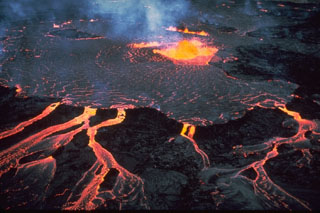Report on Kilauea (United States) — 14 May-20 May 2025
Smithsonian Institution / US Geological Survey
Weekly Volcanic Activity Report, 14 May-20 May 2025
Managing Editor: Sally Sennert.
Please cite this report as:
Global Volcanism Program, 2025. Report on Kilauea (United States) (Sennert, S, ed.). Weekly Volcanic Activity Report, 14 May-20 May 2025. Smithsonian Institution and US Geological Survey.
Kilauea
United States
19.421°N, 155.287°W; summit elev. 1222 m
All times are local (unless otherwise noted)
The Hawaiian Volcano Observatory (HVO) reported that the eruption within Kilauea’s Kaluapele summit caldera, from two vents along the SW margin of Halema’uma’u Crater, continued at variable levels during 14-20 May. Incandescence at both the N and S vents was visible during 13-16 May, and occasional spattering at the N vent occurred during the evening of 14 May. Small, sporadic, “gas-piston” events that produced spatter fountains and short lava flows began at the N vent at 2245 on 15 May. Five more “gas-piston” events and lava flows occurred the next morning at 0030, 0100, 0125, 0154, and 0243 on 16 May. Dome fountains overflowed the crater at 0440, and sustained high fountaining began at 0513. Fountain heights peaked at 300 m around 0600, then began to oscillate between 100 and 150 m. By 0610 the fountains were producing multiple lava flows that covered about 30-40 percent of the crater floor. The gas plume rose as high as 3 km and drifted WSW, away from populated areas. Sulfur dioxide emission rates were expected to be similar to those recorded during other moderate-to-high fountaining episodes, or around 50,000 tonnes per day (t/d). After over 10 hours of high fountains, that activity ceased at 1529 after an estimated 3.8 million cubic meters of lava had been erupted.
Incandescence from the lava flows was visible near the active vent region and along the N margin of the crater floor overnight during 16-17 May, and incandescence at both the N and S vents was visible during 16-20 May. The Volcano Alert Level remained at Watch (the third level on a four-level scale) and the Aviation Color Code remained at Orange (the third color on a four-color scale).
Geological Summary. Kilauea overlaps the E flank of the massive Mauna Loa shield volcano in the island of Hawaii. Eruptions are prominent in Polynesian legends; written documentation since 1820 records frequent summit and flank lava flow eruptions interspersed with periods of long-term lava lake activity at Halemaumau crater in the summit caldera until 1924. The 3 x 5 km caldera was formed in several stages about 1,500 years ago and during the 18th century; eruptions have also originated from the lengthy East and Southwest rift zones, which extend to the ocean in both directions. About 90% of the surface of the basaltic shield volcano is formed of lava flows less than about 1,100 years old; 70% of the surface is younger than 600 years. The long-term eruption from the East rift zone between 1983 and 2018 produced lava flows covering more than 100 km2, destroyed hundreds of houses, and added new coastline.
Source: US Geological Survey Hawaiian Volcano Observatory (HVO)

